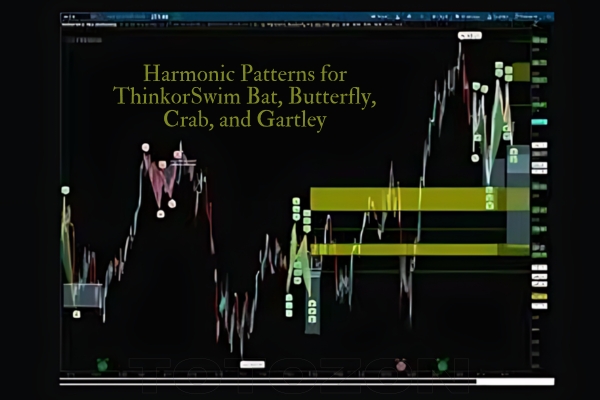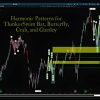Harmonic Patterns for ThinkorSwim Bat, Butterfly, Crab, and Gartley
$6.00
File Size: Coming soon!
Delivery Time: 1–12 hours
Media Type: Online Course
Harmonic Patterns for ThinkorSwim: Bat, Butterfly, Crab, and Gartley
Harmonic patterns are essential tools in technical analysis, helping traders predict market movements with precision. When used with ThinkorSwim, these patterns can significantly enhance your trading strategy. This article explores the Bat, Butterfly, Crab, and Gartley patterns, offering insights on how to utilize them effectively within the ThinkorSwim platform.
Introduction to Harmonic Patterns
What Are Harmonic Patterns?
Harmonic patterns are specific price formations based on Fibonacci ratios that indicate potential reversals in market trends. These patterns help traders identify high-probability setups by recognizing the natural order within the price action.
Benefits of Using Harmonic Patterns
- Predictive Accuracy: Provide precise entry and exit points.
- Risk Management: Help in setting tight stop-loss levels.
- Versatility: Applicable to various financial markets and timeframes.
Setting Up Harmonic Patterns in ThinkorSwim
Installing ThinkorSwim
- Download: Obtain the ThinkorSwim platform from the TD Ameritrade website.
- Install: Follow the installation instructions to set up the platform on your device.
- Login: Access your account and start configuring the platform.
Adding Harmonic Patterns
- Indicator Setup: Navigate to the ‘Studies’ tab and search for harmonic pattern indicators.
- Custom Scripts: Use ThinkScript to create custom harmonic pattern indicators if necessary.
Understanding the Bat Pattern
Structure of the Bat Pattern
- XABCD Formation: The Bat pattern consists of four legs (X to A, A to B, B to C, and C to D) with specific Fibonacci retracement levels.
- Ratios: Key Fibonacci ratios include 0.382 or 0.50 retracement of XA, and 0.886 retracement of XA at point D.
Identifying the Bat Pattern
- Bullish Bat: Look for price action that completes at point D within the specified Fibonacci range, indicating a potential upward reversal.
- Bearish Bat: Opposite of the Bullish Bat, indicating a downward reversal.
Trading the Bat Pattern
- Entry Point: Enter at point D when the price action confirms the pattern.
- Stop-Loss: Place a stop-loss slightly below (for bullish) or above (for bearish) point X.
- Take Profit: Use Fibonacci extensions to set take profit levels.
Exploring the Butterfly Pattern
Structure of the Butterfly Pattern
- XABCD Formation: Similar to the Bat pattern but with different Fibonacci ratios.
- Ratios: Key ratios include a 0.786 retracement of XA for point B, and an extended AB=CD pattern.
Identifying the Butterfly Pattern
- Bullish Butterfly: Look for completion at point D with a 1.272 or 1.618 extension of XA.
- Bearish Butterfly: Indicates a potential reversal to the downside when the pattern completes.
Trading the Butterfly Pattern
- Entry Point: Enter the trade at point D.
- Stop-Loss: Set below (for bullish) or above (for bearish) point X.
- Take Profit: Target the 1.272 or 1.618 extension levels.
Understanding the Crab Pattern
Structure of the Crab Pattern
- XABCD Formation: The Crab pattern features a deep retracement and a sharp extension.
- Ratios: Includes a 0.382 or 0.618 retracement of XA and a 2.618 extension of XA at point D.
Identifying the Crab Pattern
- Bullish Crab: Look for a deep retracement followed by a sharp reversal at point D.
- Bearish Crab: Indicates a downward reversal with similar characteristics in the opposite direction.
Trading the Crab Pattern
- Entry Point: Enter at point D when the pattern completes.
- Stop-Loss: Place below (for bullish) or above (for bearish) point X.
- Take Profit: Use Fibonacci extensions like 2.618 for setting profit targets.
Exploring the Gartley Pattern
Structure of the Gartley Pattern
- XABCD Formation: The Gartley pattern is characterized by a moderate retracement and extension.
- Ratios: Key ratios include a 0.618 retracement of XA and a 1.27 extension of AB.
Identifying the Gartley Pattern
- Bullish Gartley: Completion at point D indicates a potential upward move.
- Bearish Gartley: Suggests a downward reversal at point D.
Trading the Gartley Pattern
- Entry Point: Enter at point D when the price action confirms the pattern.
- Stop-Loss: Set below (for bullish) or above (for bearish) point X.
- Take Profit: Target Fibonacci extension levels for taking profit.
Practical Applications in ThinkorSwim
Combining Indicators
- Volume Analysis: Combine harmonic patterns with volume indicators to confirm signals.
- Moving Averages: Use moving averages to identify trend direction and strength.
Backtesting Strategies
- Historical Data: Use ThinkorSwim’s backtesting feature to test harmonic patterns on historical data.
- Optimize Settings: Adjust parameters based on backtesting results for better accuracy.
Risk Management
- Position Sizing: Use proper position sizing techniques to manage risk.
- Stop-Loss Placement: Always set stop-loss orders based on the pattern’s structure.
Advantages of Using Harmonic Patterns
Precision
- Accurate Predictions: Harmonic patterns provide precise entry and exit points.
- Clear Structure: The structured nature of patterns helps in disciplined trading.
Flexibility
- Multiple Markets: Applicable across different financial markets.
- Various Timeframes: Effective in various timeframes, from intraday to long-term trading.
Improved Risk Management
- Defined Levels: Clear stop-loss and take profit levels help in managing risk effectively.
- Consistent Results: Enhances consistency in trading outcomes.
Conclusion
Harmonic patterns, such as the Bat, Butterfly, Crab, and Gartley, offer traders a powerful tool for predicting market movements with ThinkorSwim. By understanding these patterns and incorporating them into your trading strategy, you can enhance your precision and profitability. Embrace these patterns to navigate the complexities of the financial markets with confidence and accuracy.

Commonly Asked Questions:
- Business Model Innovation: Accept the truth of a legitimate business! Our strategy is organising a group buy in which participants share the costs. We use these cash to acquire popular courses from sale pages and make them available to people with limited financial resources. Despite the authors’ worries, our clients love the cost and accessibility we give.
- The Legal Environment: Yes or No The legality of our activity is ambiguous. While we don’t have specific permission from the course authors to resell the material, there is a technicality at work. The author did not specify any limits on resale when purchasing the course. This legal intricacy is both an opportunity for us and a boon for individuals looking for low-cost access.
- Quality Control: Uncovering the Truth
Getting to the heart of the issue – quality. Purchasing the course straight from the sale page guarantees that all documents and resources are the same as those obtained through traditional channels.
However, we distinguish ourselves by going beyond personal research and resale. It is crucial to note that we are not the official course providers, which means that the following premium services are not included in our package:
- There are no scheduled coaching calls or sessions with the author.
- Access to the author’s private Facebook group or web portal is not permitted.
- No access to the author’s private membership forum.
- There is no direct email support available from the author or their team.
We operate independently, with the goal of bridging the pricing gap without the extra services provided by official course channels. Your comprehension of our distinct approach is much appreciated.
Be the first to review “Harmonic Patterns for ThinkorSwim Bat, Butterfly, Crab, and Gartley” Cancel reply
You must be logged in to post a review.
Related products
Forex Trading
Forex Trading
Forex Trading
Forex Trading
Quantamentals – The Next Great Forefront Of Trading and Investing with Trading Markets
Forex Trading
Forex Trading
Forex Trading
Forex Trading
Forex Trading
Forex Trading
Forex Trading
Forex Trading





















Reviews
There are no reviews yet.